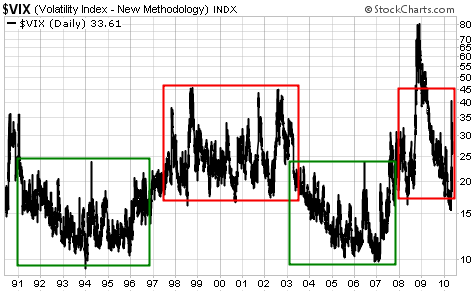| Home | About Us | Resources | Archive | Free Reports | Market Window |
How to Make 15% Dividends and 50% Gains in a Turbulent MarketBy
Tuesday, May 18, 2010
Back in February, I predicted stock market volatility would rise. It was one of the most compelling trades I've ever seen...
You can trade volatility like any other commodity. It's traded in Chicago, right alongside pork bellies, orange juice, and Treasury bonds. It's a futures market. If you think volatility's going to rise, you buy the futures. If you think it's going to fall, you sell the futures. There's also an exchange-traded fund (ETF) for volatility. Its symbol is VXX.
"One of the best volatility trading opportunities I've ever seen is setting up right now," I wrote. "I believe you'll make a quick 50% gain in this trade, and with some luck, you could make as much as 100%... in a few weeks."
I formed my prediction from the chart below. Volatility tends to move in multiyear cycles. You'll get long periods of almost no volatility, like the 1940s, 1950s, and 1960s. Then, you get long periods of high volatility, like the 1930s.
The VIX is an index of volatility for the S&P 500. It's the most popular index of volatility. This 20-year chart of the VIX illustrates these cycles perfectly. There was almost no volatility between 1992 and 1997 or between 2004 and 2007. But between 1998 and 2003, when tech stocks boomed and then busted, volatility traded on a much higher plateau.
Right now, America is mired in government manipulation, instability, and economic turmoil. In other words, I believe the stock markets have entered a new era of elevated volatility, similar to what occurred between 1997 and 2003 in this chart…
 If I'm right about the long-term trends in the VIX, and the new elevated plateau for volatility, then all you have to do to make a fortune from volatility is buy whenever the VIX falls to 17.5, and sell whenever it rises above 45.
This system has worked spectacularly so far this year.
Volatility dropped below 17.5 in March and stayed there until mid-April. You had around six weeks to place the trade.
In the first week of May, volatility began to rise with anxiety about Greek debt and the euro. Then on Friday, May 7, the VIX soared over 42 after a computer glitch caused the stock market to suddenly crash. The VIX is still trading at high levels... currently around 35. If you'd entered this trade using the volatility ETF VXX, you'd currently be showing a profit of over 50%.
For the final step, you'll wait for the VIX to trade above 45, and then sell your position.
Also, with the VIX above 45, writing covered calls becomes one of the most profitable investment strategies in the world. The VIX is an indicator of option prices. When you write covered calls, you sell expensive options against a basket of blue-chip stocks. And you can generate a reliable 15% income stream while you wait for the VIX to fall below 17.5 again.
The bottom line is if America has entered a new era of volatility, using the VIX to trade will be one of the easiest ways to make money in the stock market over the next few years. Simply buy volatility when the VIX falls below 17.5 and sell when the VIX rises above 45. Write covered calls while you wait for the VIX to return to 17.5.
While you may have missed the most recent trade, don't worry… we'll get another chance soon. And we're on our way to covered call territory.
Good investing,
Further Reading:
Back in February, Steve noted another way to profit from market volatility. It only takes 10 minutes a month to implement this idea, and it produces extraordinary results. Steve calls it "The Ultimate System for a Volatile Market."
Market NotesTHE WORST CHART IN THE WORLD It's getting easier to convince the average American to buy gold… You can thank the plunging euro currency for the new state of affairs.
Back in December, we identified the classic "1-2-3 trend change" in the euro… and we’ve highlighted its demise nearly every week. The pan-European currency just struck its lowest low since 2006. It now sports one of the most gruesome charts you can find anywhere. Why is this currency plunge bullish for gold? Americans occasionally hear about an odd currency crisis happening far off in Thailand, Zimbabwe, or Argentina. But the current crisis in Europe is much more real…
Europe is as developed as the U.S. Many Americans have relatives there. Europe is home to familiar names like Ikea, Volkswagen, Shell, Nokia, and Nestle. All this makes hearing that the region’s currency is crumbling different than hearing about problems in Thailand… and it works to get folks nervous about the U.S. dollar… which, like the euro, is managed by a spendthrift government.
We doubt the euro's decline will cause every American to run out and buy gold. But it will cause many "fence sitters" to take notice. Paper currencies are under immense and growing debt loads. The decline in the euro will cause many Americans to visit the nearest bullion dealer to buy a few ounces. Long term, this is bullish for gold.
|
In The Daily Crux
Recent Articles
|

